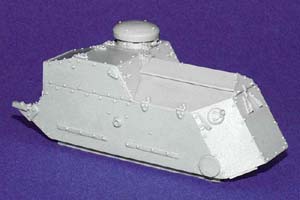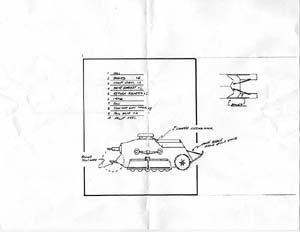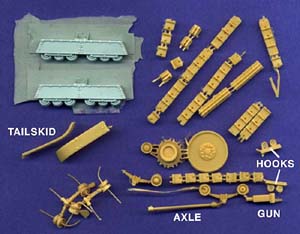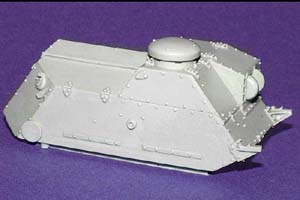From Internet Modeler
Commander Series' 1/35 Ford 3-Ton Tank (1918)
By Karen Rychlewski
Feb 1, 2002 - 5:47:00 PM
History
In mid-1918, the U.S. Ordnance Department began designing this tiny tank, making it the first tank-type vehicle to be a completely American project. Armored cars had already been manufactured in the U.S., notably by the Packard, Cadillac, and International (Mack) Motor Companies, and tank production based on British and French designs was already underway. But it was felt there was a need for a small, light tank for infantry support. The Ford Motor Company was selected to mass-produce this tank at a rate of 100 per day (!) so the design incorporated many standard Ford automobile parts. Nevertheless, the exterior design owed much to the French FT-17. A prototype was sent to France in October and received good ratings which resulted in an order for 15,000 units. There were ambitious plans to use the vehicle as a machine gun and ammunition carrier, a cargo carrier, a tractor, and a self-propelled howitzer. However, after the Armistice the order was cancelled--only fifteen vehicles were finished. There is at least one survivor: at the Patton Museum in Ft. Knox, Kentucky.
The tank did indeed weigh slightly less than three tons, with a length of nearly 14 feet, and both width and height just under 6 feet. It was powered by two Model T Ford engines, each with its own electric starter and three-speed transmission (two forward, one reverse). The engines together produced forty-five horsepower and the maximum speed was 8 mph. Designed without a turret, it carried only one machine gun mounted at the front with quite limited movement. Even for just two people, the interior was cramped and uncomfortable. It is interesting to speculate the course of armored vehicle development in the U.S. had this little terrier not been put down.
The Kit
 Commander Series Models, Inc. of Rochester NY, produces an extensive line of ships in various scales and armored vehicles in 1/35. The primary components are resin cast and the kits often include white metal and photo-etched parts. Some include dry transfer markings. The casting quality can vary from excellent to potholed, but Commander has a 'customer satisfaction guarantee' and will replace the occasional part or kit which is less than ideal. I cannot comment on the ship kits, but the vehicle kits are sparse in the instructions department. These are kits intended for experienced modelers with deep sources of reference.
Commander Series Models, Inc. of Rochester NY, produces an extensive line of ships in various scales and armored vehicles in 1/35. The primary components are resin cast and the kits often include white metal and photo-etched parts. Some include dry transfer markings. The casting quality can vary from excellent to potholed, but Commander has a 'customer satisfaction guarantee' and will replace the occasional part or kit which is less than ideal. I cannot comment on the ship kits, but the vehicle kits are sparse in the instructions department. These are kits intended for experienced modelers with deep sources of reference.
The Ford 3-Ton kit comes packaged in a sturdy corrugated cardboard box; other Commander kits have a photo of the completed model on the boxtop--my example did not. And no photos or detailed scale drawings appear on the instructions. A definite drawback, since references for this vehicle are not exactly overwhelming. On the other hand, the kit is relatively simple and someone at least moderately familiar with tank anatomy should have little trouble figuring out what goes where. The best two reference sources I found are listed at the bottom of this review.
 Onward to the box contents. The entire hull of the tank is one solid chunk of very nicely cast light grey resin. Edges, rivets, hinges, panel lines, and assorted bolted-on flanges are flawless, with sharp detail and no flash whatsoever, although the flat surfaces have a very slight 'sandpapery' texture; cleanup should be minimal. The entire bottom has a 1/16 inch 'platform' which I think needs to be removed--this will create a lot of resin dust but shouldn't be too difficult (just tedious) with a Dremel rotary file.
Onward to the box contents. The entire hull of the tank is one solid chunk of very nicely cast light grey resin. Edges, rivets, hinges, panel lines, and assorted bolted-on flanges are flawless, with sharp detail and no flash whatsoever, although the flat surfaces have a very slight 'sandpapery' texture; cleanup should be minimal. The entire bottom has a 1/16 inch 'platform' which I think needs to be removed--this will create a lot of resin dust but shouldn't be too difficult (just tedious) with a Dremel rotary file.
All of the pieces for the track units come loose in four plastic bags. The bogie units for each side are cast as two identical single pieces in a light blue resin with easily removable carrier flash. Again, the casting is very good with details only slightly softer than the body and only one tiny pinhole on a wheel edge. The 'sandpaper' texture is slightly more evident. The wheel flanges which fit into the track groove are very thin and delicate and care will have to be taken to not break them. The truly obsessive modeler will want to grind out the space between the two sets of three bogies and open the two holes on the ends, but this will barely be visible when the model is completed.
 Now the fun part: all the delicate little pieces for the rest of the track mechanism. The parts spread photo includes the parts for just one side. The front wheel, drive sprockets, return rollers, and track links are cast in a pale yellow resin to a much lower standard--which is unfortunate because these tiny parts will be quite difficult to clean up. Although the detail is good, there are some pits and missing flanges and the surfaces are distinctly rough with swirls, almost wrinkles, in addition to the pebbly texture. I doubt this can be passed off as replicating the metal surface; and it will be extremely difficult to smooth the surfaces without losing detail. Two extra pieces of the most delicate part, the return rollers, are supplied to compensate for breakage; and in fact two of the four return rollers were already broken when I opened the box. The track links are supplied in several pieces of varying lengths and a dozen or so individual links; this should make building the tracks more painless, but the track links share the problems described above. To make life easier, Commander includes an entire duplicate set of all pieces for both sides of the track unit, so you can happily break a few pieces and not have to make a frantic call in the middle of the night. Nice touch, Commander! The front axle, machine gun, several hooks, and a two-piece tail skid complete the kit parts; all of these are also cast in the yellow resin. There are no transfers included, as the tank apparently had no markings. Four tail skid braces will have to be easily scratched from strip stock.
Now the fun part: all the delicate little pieces for the rest of the track mechanism. The parts spread photo includes the parts for just one side. The front wheel, drive sprockets, return rollers, and track links are cast in a pale yellow resin to a much lower standard--which is unfortunate because these tiny parts will be quite difficult to clean up. Although the detail is good, there are some pits and missing flanges and the surfaces are distinctly rough with swirls, almost wrinkles, in addition to the pebbly texture. I doubt this can be passed off as replicating the metal surface; and it will be extremely difficult to smooth the surfaces without losing detail. Two extra pieces of the most delicate part, the return rollers, are supplied to compensate for breakage; and in fact two of the four return rollers were already broken when I opened the box. The track links are supplied in several pieces of varying lengths and a dozen or so individual links; this should make building the tracks more painless, but the track links share the problems described above. To make life easier, Commander includes an entire duplicate set of all pieces for both sides of the track unit, so you can happily break a few pieces and not have to make a frantic call in the middle of the night. Nice touch, Commander! The front axle, machine gun, several hooks, and a two-piece tail skid complete the kit parts; all of these are also cast in the yellow resin. There are no transfers included, as the tank apparently had no markings. Four tail skid braces will have to be easily scratched from strip stock.
Conclusion
The kit provides all the pieces needed to build a well-detailed model of this historically important tank, but it's not a kit for a beginner. The cleanup of the large parts is easy; on the small parts the amount of fussing will depend on the patience of the modeler. Painting will be a cinch; except for the track links and springs, it's all one color--a brownish OD if my references are correct. And so we come to the bottom line: is this kit worth the $65.00 price? Well, if you're a modeler building a historically complete collection of tanks, probably "yes" since it's the only kit in town of this vehicle. It will look really cool next to a Sherman. If you're just looking for a fun weekend build, the cost is probably higher than you want to invest. If you're a scratchbuilder, good luck...let me know if you find plans for this tank somewhere. But if you can solve the cleanup difficulties associated with the tracks, you'll have a fine little model which should elicit a lot of comments along the lines of "What IS that?"
References
"Tanks and Other Armored Fighting Vehicles 1900 to 1918" B.T. White, Macmillan Co., NY, 1970
Gracious thanks to Ted Paris of Commander Series Models, Inc. for supplying the kit.
© Copyright 2023 by Internet Modeler


 Commander Series Models, Inc. of Rochester NY, produces an extensive line of ships in various scales and armored vehicles in 1/35. The primary components are resin cast and the kits often include white metal and photo-etched parts. Some include dry transfer markings. The casting quality can vary from excellent to potholed, but Commander has a 'customer satisfaction guarantee' and will replace the occasional part or kit which is less than ideal. I cannot comment on the ship kits, but the vehicle kits are sparse in the instructions department. These are kits intended for experienced modelers with deep sources of reference.
Commander Series Models, Inc. of Rochester NY, produces an extensive line of ships in various scales and armored vehicles in 1/35. The primary components are resin cast and the kits often include white metal and photo-etched parts. Some include dry transfer markings. The casting quality can vary from excellent to potholed, but Commander has a 'customer satisfaction guarantee' and will replace the occasional part or kit which is less than ideal. I cannot comment on the ship kits, but the vehicle kits are sparse in the instructions department. These are kits intended for experienced modelers with deep sources of reference. Onward to the box contents. The entire hull of the tank is one solid chunk of very nicely cast light grey resin. Edges, rivets, hinges, panel lines, and assorted bolted-on flanges are flawless, with sharp detail and no flash whatsoever, although the flat surfaces have a very slight 'sandpapery' texture; cleanup should be minimal. The entire bottom has a 1/16 inch 'platform' which I think needs to be removed--this will create a lot of resin dust but shouldn't be too difficult (just tedious) with a Dremel rotary file.
Onward to the box contents. The entire hull of the tank is one solid chunk of very nicely cast light grey resin. Edges, rivets, hinges, panel lines, and assorted bolted-on flanges are flawless, with sharp detail and no flash whatsoever, although the flat surfaces have a very slight 'sandpapery' texture; cleanup should be minimal. The entire bottom has a 1/16 inch 'platform' which I think needs to be removed--this will create a lot of resin dust but shouldn't be too difficult (just tedious) with a Dremel rotary file. Now the fun part: all the delicate little pieces for the rest of the track mechanism. The parts spread photo includes the parts for just one side. The front wheel, drive sprockets, return rollers, and track links are cast in a pale yellow resin to a much lower standard--which is unfortunate because these tiny parts will be quite difficult to clean up. Although the detail is good, there are some pits and missing flanges and the surfaces are distinctly rough with swirls, almost wrinkles, in addition to the pebbly texture. I doubt this can be passed off as replicating the metal surface; and it will be extremely difficult to smooth the surfaces without losing detail. Two extra pieces of the most delicate part, the return rollers, are supplied to compensate for breakage; and in fact two of the four return rollers were already broken when I opened the box. The track links are supplied in several pieces of varying lengths and a dozen or so individual links; this should make building the tracks more painless, but the track links share the problems described above. To make life easier, Commander includes an entire duplicate set of all pieces for both sides of the track unit, so you can happily break a few pieces and not have to make a frantic call in the middle of the night. Nice touch, Commander! The front axle, machine gun, several hooks, and a two-piece tail skid complete the kit parts; all of these are also cast in the yellow resin. There are no transfers included, as the tank apparently had no markings. Four tail skid braces will have to be easily scratched from strip stock.
Now the fun part: all the delicate little pieces for the rest of the track mechanism. The parts spread photo includes the parts for just one side. The front wheel, drive sprockets, return rollers, and track links are cast in a pale yellow resin to a much lower standard--which is unfortunate because these tiny parts will be quite difficult to clean up. Although the detail is good, there are some pits and missing flanges and the surfaces are distinctly rough with swirls, almost wrinkles, in addition to the pebbly texture. I doubt this can be passed off as replicating the metal surface; and it will be extremely difficult to smooth the surfaces without losing detail. Two extra pieces of the most delicate part, the return rollers, are supplied to compensate for breakage; and in fact two of the four return rollers were already broken when I opened the box. The track links are supplied in several pieces of varying lengths and a dozen or so individual links; this should make building the tracks more painless, but the track links share the problems described above. To make life easier, Commander includes an entire duplicate set of all pieces for both sides of the track unit, so you can happily break a few pieces and not have to make a frantic call in the middle of the night. Nice touch, Commander! The front axle, machine gun, several hooks, and a two-piece tail skid complete the kit parts; all of these are also cast in the yellow resin. There are no transfers included, as the tank apparently had no markings. Four tail skid braces will have to be easily scratched from strip stock.